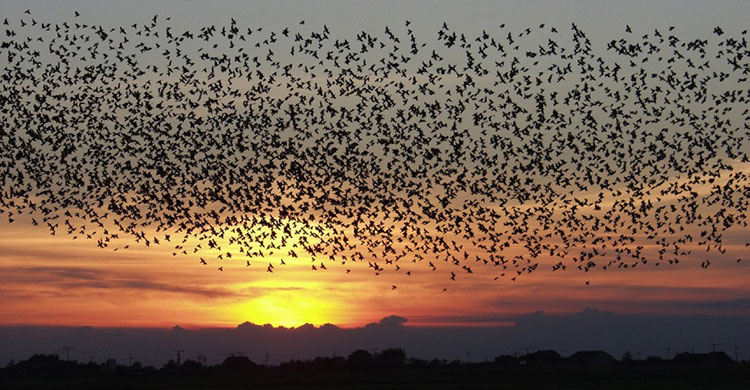Filling in the Missing Link: AfriBiRds Programme to Monitor Migratory Birds

Sunset with starlings
Bonn, 07 April 2017 - With spring in full swing, millions of birds have made the epic migration from their wintering grounds in Africa to their summer breeding areas in Northern Eurasia and Arctic regions. Songs have returned to the countryside but have you ever wondered what happens to the birds that do not return from their harrowing journey?
As many as 40 per cent of these Afro-Palaearctic migrating bird species have seen declines in populations over the last few decades without much knowledge or explanation as to why. Therefore, BirdLife International African Office, in collaboration with NABU, the BirdLife partner in Germany, has started the project AfriBiRds; African Biosphere Reserves as pilot sites for monitoring and conservation of migratory birds. This project, taking place from December 2016 through August 2019, will design and implement a pilot scheme to monitor bird populations by assessing existing monitoring schemes and activities in UNESCO Biosphere Reserves in Africa. With more effective monitoring in place, AfriBiRds will help researchers and conservationists gain a better understanding of the threats facing many migratory bird species in Africa such as habitat loss and degradation at key sites, illegal taking and trade, risks of disease and collision.
Germany is a major supporter of AfriBiRds both through financial contributions and with oversight from the Federal Agency for Nature Conservation (BfN) and the Federal Ministry of Environment (BMUB). The project is closely linked with the Convention of Migratory Species (CMS)/ African-Eurasian Migratory Landbirds Action Plan (AEMLAP), a tool that aims at improving conservation status of ca 500 landbird species which are currently threatened or declining. AEMLAP was adopted by the 11th Conference of the Parties of CMS held in Quito (Ecuador) in November 2014, and includes widespread species such as the Barn Swallow, Common Cuckoo, Northern Wheatear or Whinchat. AfriBiRds will not only directly contribute to the implementation of AEMLAP but will also to broader objectives such as the Sustainable Development Goals (SDGs).
 |
 |
|
Whinchat © Ricardo Gomez-Calmaestra |
Northern wheatear © Ricardo Gomez-Calmaestra |
The project is already underway with a literature review to help choose the two Biosphere Reserves pilot sites. It will rely heavily on two frameworks currently used in many countries around the world: the Common Bird Monitoring Scheme and the Important Bird and Biodiversity Areas (IBA). Their purpose is to collect information about the trends in bird populations, habitat status, threats and the effectiveness of conservation work. A third monitoring system includes public participation through an online database where locals can make observations and record bird sightings.
After AfriBiRds has developed an on-site monitoring framework, the project will implement the monitoring for one year by collecting and analyzing data. The ultimate goal would be a representative coverage of Africa by bird monitoring schemes that would allow for the calculation of a Wild Bird Index that tracks the average trends in species abundance during the breeding season. In the future, biosphere reserves and partner organizations will be provided with guidelines to replicate the monitoring schemes on other sites in other countries.
AfriBiRds is a significant step in creating awareness about the importance of bird conservation in local communities near the biosphere reserves and worldwide. AEMLAP highlights the importance of research and monitoring to provide data that directs conservation efforts as well as the role of education and information to increase public awareness. A key element of the project consists of capacity building on the ground by involving stakeholder groups through workshops and providing essential training to local monitoring coordinators.
Migratory birds represent a vital link between Africa and Eurasia and carry many benefits across the region. They are not only beautiful to watch but are also important general indicators of the state of the environment. By gaining an understanding of their lives through monitoring, we will be in a better position to protect them.
For more information:
For more information please contact Borja Heredia at [email protected]
Information can also be found under the following links:
CMS Landbirds webpage: http://www.cms.int/en/node/4186
AEMLAP: http://www.cms.int/en/document/african-eurasian-migratory-landbirds-action-plan-aemlap-2

https://en.nabu.de/projects/afribirds/
http://www.birdlife.org/africa/projects/african-eurasian-migratory-landbirds-action-plan-aemlap
http://www.unesco.org/new/en/natural-sciences/environment/ecological-sciences/biosphere-reserves/
Last updated on 07 April 2017




